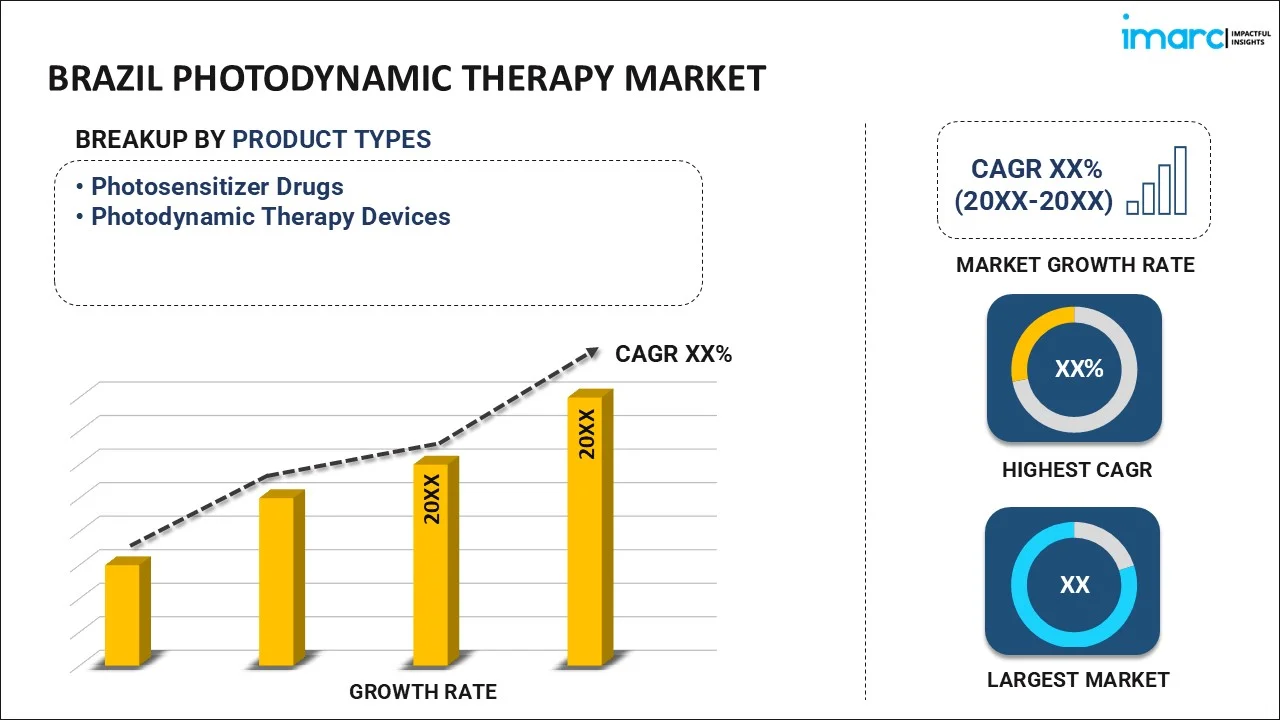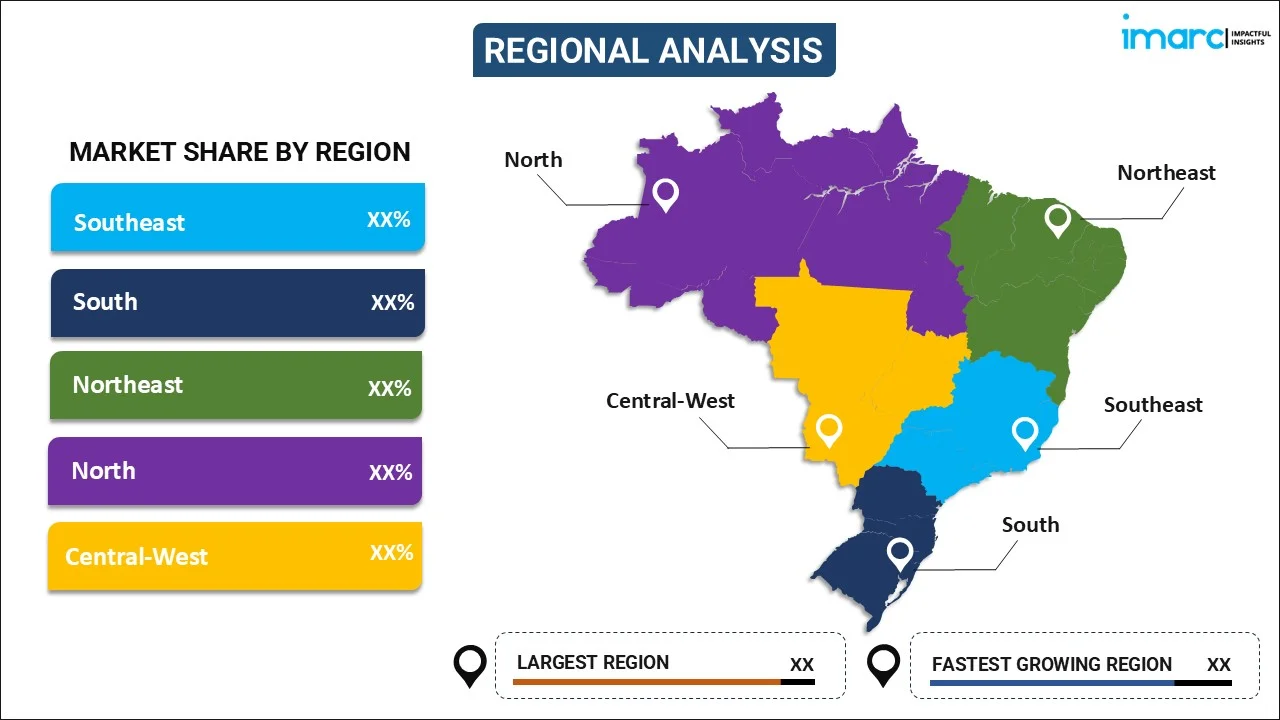
Brazil Photodynamic Therapy Market Size, Share, Trends, and Forecast by Product Type, Application, End User, and Region, 2025-2033
Brazil Photodynamic Therapy Market Overview:
The Brazil photodynamic therapy market size reached USD 40.71 Million in 2024. Looking forward, IMARC Group expects the market to reach USD 162.26 Million by 2033, exhibiting a growth rate (CAGR) of 15.38% during 2025-2033. The market is driven by the increasing incidences of cancer among the masses, rising awareness regarding photodynamic therapy, continual advancements in laser technology, the growing preference for minimally invasive treatments, escalating investments in healthcare infrastructure, strategic collaborations between research institutions and hospitals, and favorable government initiatives supporting cancer treatment.
|
Report Attribute
|
Key Statistics
|
|---|---|
|
Base Year
|
2024
|
|
Forecast Years
|
2025-2033
|
|
Historical Years
|
2019-2024
|
| Market Size in 2024 | USD 40.71 Million |
| Market Forecast in 2033 | USD 162.26 Million |
| Market Growth Rate (2025-2033) | 15.38% |
Brazil Photodynamic Therapy Market Trends:
Rising disposable incomes
The photodynamic therapy (PDT) market is significantly benefited by the inflating disposable income levels of the consumers in Brazil. For instance, as of 2023, Brazil's average household net-adjusted disposable income per capita was R$1,848 per month, marking an 11.5% increase from the previous year. With continual progress in the economic conditions and a majority of the demographic earning high disposable income, the ability to access advanced medical procedures is also increasing. Patients are more open to the idea of paying for high-end healthcare solutions that promise improved results and enhanced quality of life, especially in cases such as cancer and skin diseases in which photodynamic therapy has been proven to be useful. Furthermore, the practice of photodynamic therapy is more achievable since individuals can spend more towards healthcare. This observation is more prominent among the middle and upper classes who are more concerned with their health and wellbeing. When patients have higher disposable income, they are more likely to seek treatments such as PDT, which would have previously been considered too expensive or out of reach. Moreover, the demand for medical procedures and equipment such as the PDT apparatus is high due to the rising purchasing power. This rapid pace in the growth of the new PDT related products and services creating fierce competition among the suppliers are leading to improved service delivery to the patients.
Growing geriatric population
Considerable rise in the geriatric population in Brazil is a significant driver of the photodynamic therapy (PDT) market. For instance, as of 2024, approximately 11% of Brazil's population is aged 65 years and older, totaling around 22.2 million individuals. The expanding elderly population in Brazil is significantly driving the growth of the PDT market by contributing to a higher prevalence of conditions requiring treatment, thus facilitating the demand for innovative therapies, and compelling healthcare systems to prioritize advanced medical solutions that enhance treatment outcomes but also reduces the likelihood of complications. Moreover, older adults tend to prefer therapies that minimize side effects and offer shorter recovery times. This is resulting in a heightened demand for effective and minimally invasive treatment options, making PDT an appealing choice. Its capacity to selectively target diseased tissues while preserving healthy surrounding cells aligns with the treatment preferences of the elderly, particularly those with multiple comorbidities who require more delicate therapeutic approaches. Furthermore, healthcare systems are compelled to adapt to the specific needs of the aging population, leading to increased investments in technologies like PDT. This supports the availability of PDT as well as encourages healthcare providers to enhance their training and expertise in administering such treatments. Additionally, advancements in PDT technology are continuously improving its efficacy and safety profile, further reinforcing its suitability for the aging population and driving broader adoption within healthcare systems
Brazil Photodynamic Therapy Market Segmentation:
IMARC Group provides an analysis of the key trends in each segment of the market, along with forecasts at the country level for 2025-2033. Our report has categorized the market based on product type, application, and end user.
Product Type Insights:

- Photosensitizer Drugs
- Photodynamic Therapy Devices
The report has provided a detailed breakup and analysis of the market based on the product type. This includes photosensitizer drugs and photodynamic therapy devices.
Application Insights:
- Cancer
- Actinic Keratosis
- Acne
- Psoriasis
- Others
A detailed breakup and analysis of the market based on the application have also been provided in the report. This includes cancer, actinic keratosis, acne, psoriasis, and others.
End User Insights:
- Hospitals
- Speciality Clinics
- Others
The report has provided a detailed breakup and analysis of the market based on the end user. This includes hospitals, speciality clinics, and others.
Regional Insights:

- Southeast
- South
- Northeast
- North
- Central-West
The report has also provided a comprehensive analysis of all the major regional markets, which include Southeast, South, Northeast, North, and Central-West.
Competitive Landscape:
The market research report has also provided a comprehensive analysis of the competitive landscape. Competitive analysis such as market structure, key player positioning, top winning strategies, competitive dashboard, and company evaluation quadrant has been covered in the report. Also, detailed profiles of all major companies have been provided.
Brazil Photodynamic Therapy Market News:
- In June 2024, Researchers from Brazil’s CePOF, in collaboration with the University of Toronto and Princess Margaret Cancer Center, announced the successful utilization of pulsed laser phototherapy to treat ocular melanoma in mice, offering a promising, non-invasive alternative to current, more drastic treatments for the disease.
Brazil Photodynamic Therapy Market Report Coverage:
| Report Features | Details |
|---|---|
| Base Year of the Analysis | 2024 |
| Historical Period | 2019-2024 |
| Forecast Period | 2025-2033 |
| Units | Million USD |
| Scope of the Report |
Exploration of Historical Trends and Market Outlook, Industry Catalysts and Challenges, Segment-Wise Historical and Future Market Assessment:
|
| Product Types Covered | Photosensitizer Drugs, Photodynamic Therapy Devices |
| Applications Covered | Cancer, Actinic Keratosis, Acne, Psoriasis, Others |
| End Users Covered | Hospitals, Speciality Clinics, Others |
| Regions Covered | Southeast, South, Northeast, North, Central-West |
| Customization Scope | 10% Free Customization |
| Post-Sale Analyst Support | 10-12 Weeks |
| Delivery Format | PDF and Excel through Email (We can also provide the editable version of the report in PPT/Word format on special request) |
Key Questions Answered in This Report:
- How has the Brazil photodynamic therapy market performed so far and how will it perform in the coming years?
- What is the breakup of the Brazil photodynamic therapy market on the basis of product type?
- What is the breakup of the Brazil photodynamic therapy market on the basis of application?
- What is the breakup of the Brazil photodynamic therapy market on the basis of end user?
- What is the breakup of the Brazil photodynamic therapy market on the basis of region?
- What are the various stages in the value chain of the Brazil photodynamic therapy market?
- What are the key driving factors and challenges in the Brazil photodynamic therapy market?
- What is the structure of the Brazil photodynamic therapy market and who are the key players?
- What is the degree of competition in the Brazil photodynamic therapy market?
Key Benefits for Stakeholders:
- IMARC’s industry report offers a comprehensive quantitative analysis of various market segments, historical and current market trends, market forecasts, and dynamics of the Brazil photodynamic therapy market from 2019-2033.
- The research report provides the latest information on the market drivers, challenges, and opportunities in the Brazil photodynamic therapy market.
- Porter's five forces analysis assist stakeholders in assessing the impact of new entrants, competitive rivalry, supplier power, buyer power, and the threat of substitution. It helps stakeholders to analyze the level of competition within the Brazil photodynamic therapy industry and its attractiveness.
- Competitive landscape allows stakeholders to understand their competitive environment and provides an insight into the current positions of key players in the market.
Need more help?
- Speak to our experienced analysts for insights on the current market scenarios.
- Include additional segments and countries to customize the report as per your requirement.
- Gain an unparalleled competitive advantage in your domain by understanding how to utilize the report and positively impacting your operations and revenue.
- For further assistance, please connect with our analysts.
 Inquire Before Buying
Inquire Before Buying
 Speak to an Analyst
Speak to an Analyst
 Request Brochure
Request Brochure
 Request Customization
Request Customization




.webp)




.webp)












